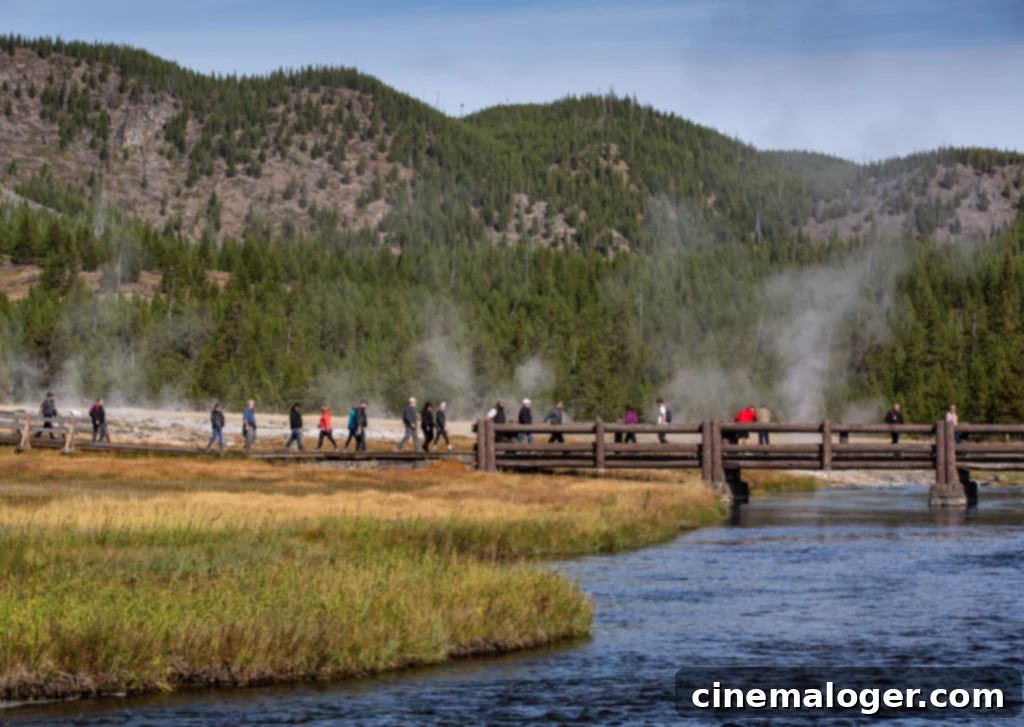Yellowstone’s Biscuit Basin Closed After Hydrothermal Explosion: Understanding Geothermal Activity and Park Safety
Yellowstone National Park, a land renowned for its breathtaking landscapes and dynamic geothermal features, recently experienced a dramatic hydrothermal explosion in its popular Biscuit Basin area. This unforeseen event, which sent rocks and debris flying, has prompted park officials to temporarily close the Biscuit Basin parking lot and boardwalks to ensure visitor safety. The incident underscores the raw, unpredictable power of nature inherent in America’s first national park and highlights the constant vigilance required to manage such a unique environment.
The explosion occurred on a Tuesday morning, approximately around 10 a.m. local time, originating near the Black Diamond Pool within the Biscuit Basin thermal area. The force of the blast caused significant damage to the pedestrian boardwalks, making the area hazardous for visitors. Following the event, park geologists from the U.S. Geological Survey (USGS) immediately launched an investigation to understand the exact nature and extent of what transpired. The Biscuit Basin, a beloved tourist destination situated roughly two miles northwest of the iconic Old Faithful geyser, will remain closed until a thorough assessment is complete and any necessary repairs are made.
Thankfully, despite the dramatic nature of the explosion and the damage caused, initial reports confirm that no injuries were sustained. Michael Poland, the scientist-in-charge at the U.S. Geological Survey’s Yellowstone Volcano Observatory (YVO), released an information statement shortly after the incident. He emphasized that continuous monitoring data for the Yellowstone region showed no unusual changes, reassuring the public that the explosion was an isolated hydrothermal event and not indicative of increased volcanic activity within the park’s deeper magmatic system.
Poland further clarified, “Today’s explosion does not reflect activity within the volcanic system, which remains at normal background levels of activity. Hydrothermal explosions like that of today are not a sign of impending volcanic eruptions, and they are not caused by magma rising towards the surface.” This distinction is crucial for understanding Yellowstone’s complex geology. While the park sits atop one of the world’s largest active volcanic calderas, hydrothermal explosions are surface phenomena driven by superheated water interacting with the shallow crust, distinct from the deep-seated magma movements that precede volcanic eruptions.
These hydrothermal explosions, though startling, are considered “relatively common” occurrences within Yellowstone National Park’s active thermal areas. They happen when superheated water, trapped beneath the surface under immense pressure, suddenly flashes into steam. This rapid conversion generates a powerful force that can fracture rock, create craters, and propel debris upwards, as witnessed in Biscuit Basin. Yellowstone’s extensive network of faults, fractures, and abundant groundwater, combined with heat from the underlying magma chamber, creates ideal conditions for these types of events.
Historical records show several similar incidents across Yellowstone. A notable hydrothermal explosion occurred in Biscuit Basin itself in May 2009. Prior to that, the Norris Geyser Basin, another highly active thermal area, experienced a smaller explosion on April 15 of an unspecified year, and more dramatically, Porkchop Geyser in the same basin erupted in 1989. These examples highlight the ongoing, dynamic nature of Yellowstone’s geothermal features and the need for visitors to adhere to safety guidelines, particularly by staying on designated boardwalks.

According to Mr. Poland, hydrothermal explosions can occur as often as twice a year, frequently in the park’s remote backcountry where they often go unnoticed by human observers, detected only by sophisticated monitoring equipment. However, the recent Biscuit Basin explosion was an exception. Its proximity to a popular tourist area meant it was fully documented by multiple visitors equipped with smartphones, providing dramatic footage that quickly circulated online. “It’s really quite dramatic,” Mr. Poland remarked when commenting on the intensity captured in the videos.
One such eyewitness, Facebook user Vlada March, shared her harrowing account and video footage of the explosion. She described how the event unfolded directly in front of her and her family. In a moment of sheer terror and instinct, she frantically searched for her mother while shouting for her two young sons to flee to safety. Miraculously, despite being covered in ash from head to toe, her mother escaped serious injury. March’s powerful statement on social media captured the relief and shock: “Boardwalk destroyed, my mom got some of the debris but everyone is safe. Unbelievable and grateful to be alive.”
This incident serves as a stark reminder of the dynamic and sometimes hazardous nature of Yellowstone National Park. As America’s first national park, Yellowstone is not just a scenic wonder but also a living laboratory for geological processes. It boasts more geological hydrothermal features—including geysers, mud pots, hot springs, and fumaroles—than are found in the rest of the world combined. These features are a testament to the powerful forces at play beneath the surface, continuously shaping the landscape.
Park management and the Yellowstone Volcano Observatory maintain continuous monitoring of all geothermal activity, employing a range of sensors, seismic networks, and geochemical analyses to track changes and provide early warnings when necessary. This scientific oversight, combined with strict visitor regulations like staying on designated boardwalks, is paramount to ensuring the safety of the millions who visit the park each year. While the Biscuit Basin remains temporarily closed for repairs and assessment, the event offers a powerful educational moment about the vibrant, ever-changing geology that makes Yellowstone truly unique and eternally fascinating.
Visitors planning a trip to Yellowstone National Park are encouraged to check the official park website for the latest updates on closures and safety alerts. Understanding and respecting the park’s natural processes, even the most explosive ones, is key to a safe and enriching experience in this extraordinary wilderness.